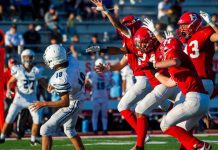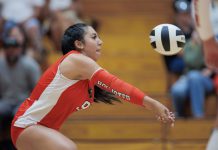In Part II of a two-part series, the Free Lance looks at what
it’s really like to ‘make weight’
… and the health risks involved
Gilroy – Ten months ago, Gilroy Hawks wrestler Fabian Loredo was “that” kid at school – heavyset and the target of his fair share of teasing. An eighth grader at South Valley Middle School, Loredo tipped the scales at 225 lbs. and the only sports he played were on video game screens.
“Am I going to be this way the rest of my life?” Loredo’s uncle, Armando Garcia, recalls the boy asking him.
Garcia told his nephew he could change. A wrestling coach at South Valley, Garcia had his nephew move in with him to do just that. Loredo began wrestling and went on a healthy diet, which was a food pyramid of magnitude away from what he had been eating – Hot Cheetos and pizza.
Cutting back wasn’t easy.
“It was real hard,” Loredo said. “At first, I felt like I was starving because I had cut down a lot. But I was still eating. Then I got used to it.”
In a matter of months, the fat melted away.
“Even after eating and everything, I’d lose two pounds a day,” Loredo said.
These days, Loredo looks nothing like his old self. At 5-foot-10, he’s a lean and muscular 155 lbs. These days, no one would dare tease Loredo.
While very few Gilroy and Hollister area wrestlers have cut as much weight as Loredo, all wrestlers must deal with shedding pounds on some level. It’s not an easy task. Ask any wrestler what it takes to make weight – words and phrases like “mental toughness,” “sacrifice,” “commitment” and “discipline” pepper their responses.
And as with any attempt to lose weight rapidly, there are always temptations for wrestlers to do it in unhealthy – and possibly dangerous – ways. This has led the National Federation of High School Athletic Associations (NFHS), with state associations like the California Interscholastic Federation (CIF) following suit, to implement wrestling weight management programs for high school wrestling. This fall, California high school wrestling teams will test run a new program, which will use the collegiate-level approach to determining a wrestler’s weight class by measuring his or her body fat percentage. The minimum body fat percentage, with some exceptions, has been determined by the NFHS as 7 percent for males and 12 percent for females.
The idea is to make sure wrestlers are competing at a healthy weight and cutting weight the right way.
How do they do it?
For the heavier wrestlers, making weight is often about controlling their big appetites.
Last season, Gilroy High head coach Armando Gonzalez wanted junior Daniel Gamez to move from the heavyweight class to 215 lbs.
“Daniel was an unhealthy person,” Gonzalez said. “He had chosen to be a serious wrestler, and in order to be an elite wrestler, you must achieve total physical fitness.”
The 6-foot-plus Gamez took on the challenge and dropped from 275 to 215 in three-and-a-half months.
“It was one of the hardest things I’ve ever done,” he said. “You have to be mentally tough to do it and be committed to what you want to do.”
Gamez ate less – a lot less – and cut out the Jack In the Box and McDonald’s, the wrestler’s fast foods of choice. He also did extra running after practices.
“There was a point in time where I just did it, I didn’t care anymore,” Gamez recalled. “I was used to it already and I just went out and ran. Even though my muscles hurt, I just did it.”
For the more lean wrestlers in the 103 to 140 weight classes, making weight is more about figuring out what Gonzalez calls “the art” of maintaining a viable wrestling weight.
After about a month of training and drilling in the wrestling room at Gilroy High in early fall, Gonzalez said he gets a better idea of the weight his wrestlers should be at. At that point, the heavier wrestlers have lost weight and leaner wrestlers have built up more muscle from the intense workouts.
Through years of experience, Gonzalez said he’s developed an eye for knowing what weight is healthiest for an individual wrestler.
“I don’t care what weight you’re at, it’s how you carry it,” he said.
Once a weight is targeted, the coaches and wrestlers follow a delicate science of balancing healthy eating with intense training to maintain weight.
“The coaches make it pretty easy on us,” said Gilroy sophomore Andreas Berragan, who wrestled at 189 lbs. this year. “They help us with our dieting. They don’t like to starve us.”
Nilo Velasquez is a San Benito High junior who comes from a wrestling family and has been wrestling since fifth grade. With the Haybalers last season, Velasquez wrestled as a 135. But in the offseason, because he’s not training as intensely and doesn’t have to make weigh-ins, Velasquez’s weight fluctuates to the low 150’s. This level of weight gain happens to most wrestlers in the offseason.
Velasquez maintains a reasonable weight by working out in the offseason and wrestling for the Razorbacks wrestling club. During the season, he watches his weight by wrestling, working out twice a day and eating six small meals instead of three big ones.
Gonzalez said he’d rather have a kid eat more than he should and work it off that not have him eat – the riskiest method of keeping weight down.
Berragan and sophomore Rudy Maldonado (119 lbs. last season) said during the season, they try to run a few extra miles on the weekend so they don’t come in too heavy for Monday practice.
Wrestling in the heat of a stuffy, enclosed wrestling room is another way grapplers maintain their weight. They pile on the sweats, thermals and Under Armour.
“They turn up the heat and we go all out,” said Maldonado.
Added Gamez, “It’s pretty hot. The windows fog up.”
During those workouts, Gonzalez said the wrestlers can easily lose up to five pounds. They then go home to eat and rehydrate, which brings some of the weight back. By the time tournament time rolls around on Saturday, they’re ready to make weight. Come Sunday, the wrestlers re-fuel, and it’s back to the practice mat on Monday.
The wrong approach
“There’s this big myth that if I lose a lot of weight, I can drop down a weight class and beat everybody,” explained Gilroy assistant wrestling coach Mike Koester. “But that doesn’t necessarily work that way because you can also lose muscle.”
San Benito’s Velasquez said he’s seen lots of wrestlers perform badly because they resort to not eating to make weight.
“They don’t wrestle the same,” he said. “Sometimes, it’s tempting (to just not eat) but I try not to do it because you get really weak.”
Dropping to a weight which is too low not only hurts a wrestler’s performance, but also his or her health.
Hollister’s Mary Margaret Lanning, a certified personal trainer, nutritional consultant and medical assistant who has been working with the San Benito wrestling team for the past several years, said she encourages already lean athletes who want to move down in weight class to build muscle instead.
“I remind them that if you go into the weight room, you will be as strong as those guys (at the higher weight class),” Lanning said. “Otherwise, you’re dropping muscle and (you’re) not as strong on the mat.”
Gonzalez believes the wrestling programs that are perennially successful are the ones that make sure their wrestlers are competing in the right weight class and being healthy. He is suspicious of programs which have wrestlers in every weight division who are consistently taller than their competition. He said such height patterns indicate that a program is “cutting their guys too extremely” for their size.
“We’ve been very lucky on the injury side and the consistency from beginning to end of the season,” Gonzalez said. “If we were cutting weight wrong or overtraining, you would see it in the results.”









